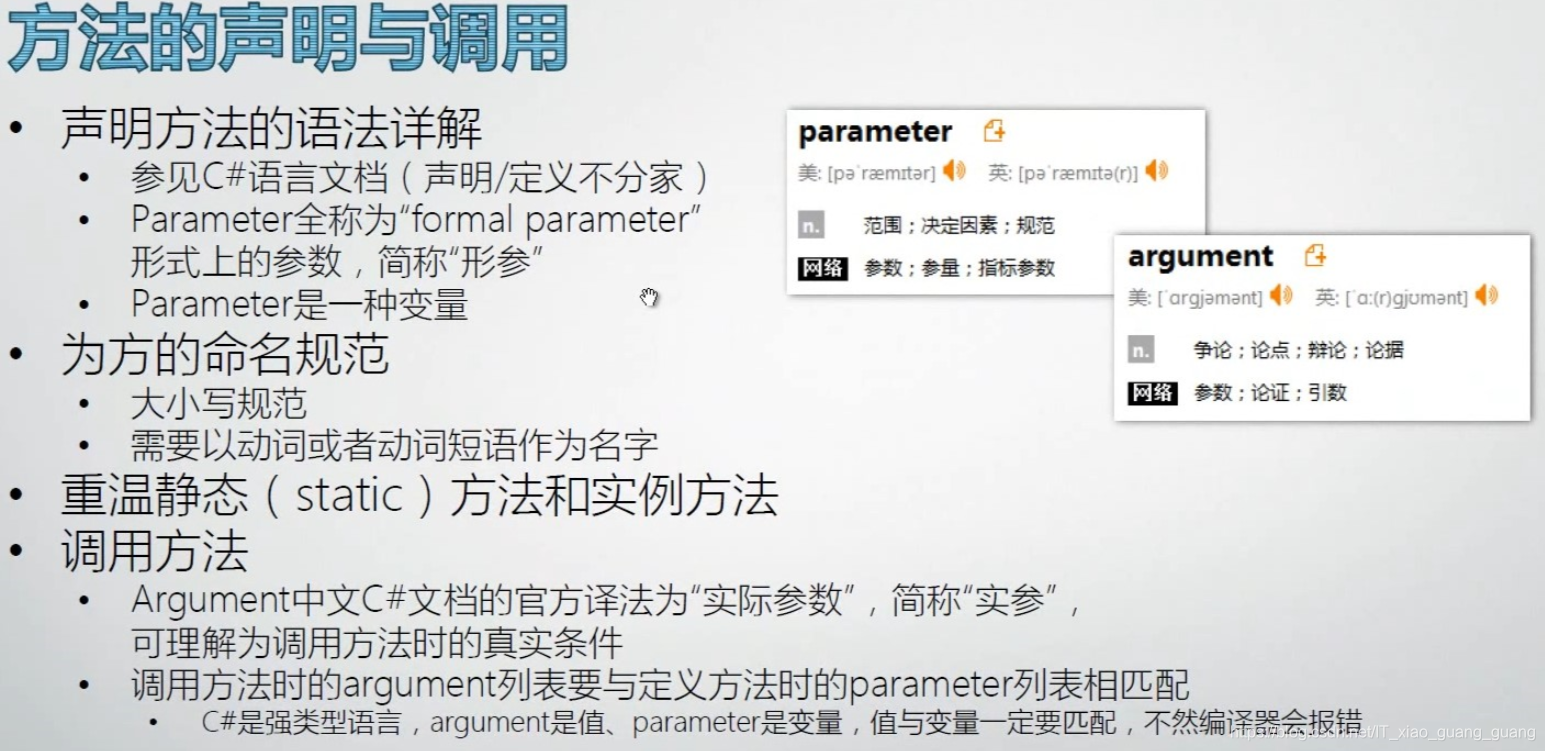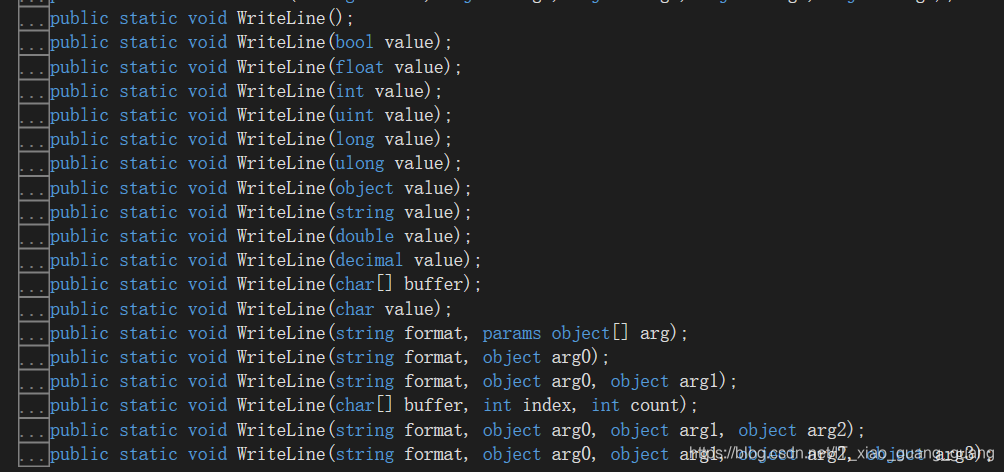文章目录
一、方法的由来
- 方法(method)的前身是 C/C++ 语言的函数(function)
- 方法是面向对象范畴的概念,在非面向对象语言中仍然称为函数
- 使用 C/C++ 语言做对比
- 方法永远都是类(或结构体)的成员
- C# 语言中函数不可能独立于类(或结构体)之外
- ☆只有作为类(或结构体)的成员时才被称为方法
- C++ 中函数可以独立于类之外,称为“全局函数”
- 方法是类(或结构体)最基本的成员之一
- 最基本的成员只有两个 —— 字段与方法(成员变量与成员方法),本质还是数据 + 算法
- 方法表示类(或结构体)“能做什么事情”
- 为什么需要方法和函数
- 目的 1:隐藏复杂的逻辑
- 目的 2:复用(reuse,重用)
- 示例:计算圆面积、圆柱体积、圆锥体积
1.C语言函数示例
/*
头文件引入到源文件后,程序可以对标准输入输出系统进行操作
stdio-标准输入输出; .h-头文件
*/
#include <stdio.h>
//Function fun
//声明Add函数-函数头+函数体
double Add(double a, double b) //函数头:函数返回值double;函数名Add;参数列表a,b
{
return a + b;
}
//在main函数里调用Add函数
int main()
{
double x = 3.0;
double y = 5.0;
double result = Add(x, y);
printf("%f+%f=%f",x,y,result); // %f-浮点数
return 0;
}
运行结果:

2.C++语言函数示例
#include <iostream>
//定义Add函数
double Add(double a, double b)
{
return a + b;
}
//在main函数里调用Add函数
int main()
{
double x = 3.0;
double y = 5.0;
double result = Add(x, y);
std::cout << x<<"+"<<y<<"="<<result;
return 0;
}
运行结果:

Notes:
①C++ 里面完成了函数向方法的过渡。
②当一个函数以类或结构体的成员的身份出现时,它就被称为方法。方法有一个别名叫“成员函数”。
3.C++语言对方法的定义和调用
例1:
Student.h:
#pragma once
class Student
{
public:
Student();
~Student();
//对方法的声明
void SayHello();
};
Student.cpp:
#include "Student.h"
#include <iostream>
Student::Student()
{
}
Student::~Student()
{
}
//方法的定义
void Student::SayHello()
{
std::cout << "Hello I'm a student!";
}
Source.cpp:
#include <iostream>
#include "Student.h" //自定义的头文件-引用Student.h
int main()
{
Student *pStu = new Student();
pStu->SayHello();
return 0;
}

例2:
Student.h:
#pragma once
class Student
{
public:
Student();
~Student();
//对Add方法的声明
double Add(double a, double b);
};
Student.cpp:
#include "Student.h"
#include <iostream>
Student::Student()
{
}
Student::~Student()
{
}
//Add方法的定义
double Student::Add(double a,double b)
{
return a + b;
}
Source.cpp:
#include <iostream>
#include "Student.h" //自定义的头文件-引用Student.h
int main()
{
Student *pStu = new Student();
double x = 3.0;
double y = 5.0;
double result = pStu->Add(x, y);
std::cout << x << "+" << y << "=" << result;
return 0;
}

Notes:
①函数在成为类的成员之后叫做方法,方法永远都是类(或结构体)的成员
②C# namespace 里不能有方法

二、方法的复用(reuse,重用)
①没有使用方法的复用
namespace CSharpMethodExample
{
class Program
{
static void Main(string[] args)
{
Calculator c = new Calculator();
Console.WriteLine(c.GetCircleArea(10));
}
}
//计算圆柱体积、圆锥体积、圆面积
class Calculator
{
//圆柱体积
public double GetCylinderVolume(double r, double h)
{
return 3.14 * r * r * h;
}
//圆锥体积
public double GetConeVolume(double r, double h)
{
return 3.14 * r * r * h / 3;
}
//圆面积
public double GetCircleArea(double r)
{
return 3.14 * r * r;
}
}
}
②使用了方法的复用
namespace CSharpMethodExample
{
class Program
{
static void Main(string[] args)
{
Calculator c = new Calculator();
Console.WriteLine(c.GetCircleArea(10));
}
}
//计算圆柱体积、圆锥体积、圆面积
class Calculator
{
//圆柱体积
public double GetCylinderVolume(double r, double h)
{
return GetCircleArea(r) * h;
}
//圆锥体积
public double GetConeVolume(double r, double h)
{
return GetCylinderVolume(r, h) * h / 3;
}
//圆面积
public double GetCircleArea(double r)
{
return 3.14 * r * r;
}
}
}
三、方法的声明与调用

1.方法的声明

2.静态(static)方法和实例方法
①实例方法(非静态方法)
namespace CSharpMethodExample
{
class Program
{
static void Main(string[] args)
{
//实例方法GetCircleArea隶属于实例c,与实例是绑定的
Calculator c = new Calculator();
Console.WriteLine(c.GetCircleArea(10));
}
}
class Calculator
{
//实例方法GetCircleArea
public double GetCircleArea(double r)
{
return 3.14 * r * r;
}
}
}
②静态方法
namespace CSharpMethodExample
{
class Program
{
static void Main(string[] args)
{
//静态GetCircleArea隶属于类Calculator,与类是绑定的
double result = Calculator.GetCircleArea(100);
Console.WriteLine(result);
}
}
class Calculator
{
//静态方法GetCircleArea
public static double GetCircleArea(double r)
{
return 3.14 * r * r;
}
}
}
3.方法的调用
namespace CSharpMethodExample
{
class Program
{
static void Main(string[] args)
{
//调用静态方法GetCircleArea,参数的类型和个数要匹配
double result = Calculator.GetCircleArea(3.0);//实参3.0
Console.WriteLine(result);
}
}
class Calculator
{
public static double GetCircleArea(double r)//形参r
{
return 3.14 * r * r;
}
}
}
四、构造器
- 构造器(constructor)是类型的成员之一
- 狭义的构造器指的是“实例构造器”(instance constructor)
- 如何使用构造器
- 声明构造器
- 构造器的内存原理
构造函数译为构造器,成员函数译为方法,它们本质都还是函数。
1.构造器的声明与调用
①默认构造器
namespace ConstructorExample
{
class Program
{
static void Main(string[] args)
{
Student stu = new Student();//()-调用Student类的构造器
Console.WriteLine(stu.ID);
}
}
/// <summary>
/// 声明一个类,没有构造器的话;使用默认构造器
/// </summary>
class Student
{
public int ID;
public string Name;
}
}
默认构造器将int型的ID初始化为0:

②无参数构造器
namespace ConstructorExample
{
class Program
{
static void Main(string[] args)
{
Student stu = new Student();//()-调用Student类的构造器
Console.WriteLine(stu.ID);
Console.WriteLine(stu.Name);
}
}
class Student
{
//自定义构造器Student
public Student()
{
this.ID = 1;
this.Name = "No Name";
}
public int ID;
public string Name;
}
}

③带参数构造器
namespace ConstructorExample
{
class Program
{
static void Main(string[] args)
{
Student stu = new Student(2, "小光光");
Console.WriteLine(stu.ID);
Console.WriteLine(stu.Name);
}
}
class Student
{
//自定义带参数构造器
public Student(int initID,string initName)
{
this.ID = initID;
this.Name = initName;
}
public int ID;
public string Name;
}
}

Code Snippet
Ctrl + Tab * 2:快速生成构造器代码片段
2.构造器内存原理
①默认构造器图示
namespace ConstructorExample
{
class Program
{
static void Main(string[] args)
{
Student stu = new Student();//引用变量-stu;实例-new Student;默认构造器-()
}
}
class Student
{
public int ID;//int是结构体类型,在内存中占4个字节
public string Name;//string是类类型-引用类型,在内存中占4个字节;存储的是实例的地址
}
}
图中左侧指的是栈,右侧指的是堆
栈内存分配是从高地址往低地址分配(二进制从下往上,从左往右),直到分配到栈顶。

②带参数构造器图示
namespace ConstructorExample
{
class Program
{
static void Main(string[] args)
{
Student stu = new Student(1,"Mr.Okay");
}
}
class Student
{
public Student(int initID,string initName)
{
this.ID = initID;
this.Name = initName;
}
public int ID;//int是结构体类型,在内存中占4个字节
public string Name;//string是类类型-引用类型,在内存中占4个字节;存储的是实例的地址
}
}

五、方法的重载(Overload)

WriteLine方法重载示例:


1.声明带有重载的方法
①方法签名中类型形参的个数构成重载:
class Calculator
{
public int Add(int a, int b)
{
return a + b;
}
public int Add<T>(int a, int b)//类型形参<T>
{
T t;//…
return a + b;
}
}
②方法签名中形参的类型(从左往右)和个数构成重载:
class Calculator
{
public int Add(int a, int b)
{
return a + b;
}
public int Add(int a, int b, int c)//形参个数不同
{
return a + b + c;
}
public double Add(int x, double y)//形参类型不同
{
return x + y;
}
}
③方法签名中形参的种类(值、引用或输出)构成重载:
class Calculator
{
public int Add(int a, int b)
{
return a + b;
}
public int Add(ref int a, int b)//形参的种类
{
return a + b;
}
}
2.重载的调用
namespace ConstructorExample
{
class Program
{
static void Main(string[] args)
{
Calculator c = new Calculator();
int x = c.Add(100, 200);
int y = c.Add(100,200,300);
double z = c.Add(100D, 200D);
}
}
class Calculator
{
public int Add(int a, int b)
{
return a + b;
}
public int Add(int a, int b, int c)
{
return a + b + c;
}
public double Add(double a, double b)
{
return a + b;
}
}
}
六、对方法进行debug
- 设置断点(breakpoint)
- 观察方法调用时的 call stack
- Step-in、Step-over、Step-out
- 观察局部变量的值与变化
①调用堆栈 (call stack)
调试状态下,菜单 调试 → 窗口 → 调用堆栈

②逐语句(Step-in)
进入调用的函数内,逐语句进行调试
③逐过程(Step-over)
④跳出(Step-out)
用于跳出当前方法并返回到调用它的方法
⑤局部变量值的变化

七、方法的调用与栈
- 方法调用时栈内存的分配
- 对 stack frame 的分析
- 对 stack frame 的分析
stack frame:一个方法被调用时,它在栈内存中的布局。
C# 中调用方法时的变量归 Caller(主调函数) 管,不归 Callee(被调用者) 管。
压变量入栈,C# 是从左至右的顺序。
图示是为了重点解释方法、变量、参数的压栈,实际情况下还要压入返回地址等。
返回值一般存在 CPU 的寄存器里面,特殊情况寄存器存不下该返回值时,会到栈上开辟空间。
stack overflow 就是栈无限向上延伸(分配变量、参数、栈针等),最后溢出了。
代码:
namespace ConstructorExample
{
class Program
{
static void Main(string[] args)
{
double a = Calculator.GetConeVolume(100, 90);//参数类型是double
}
}
class Calculator
{
//计算圆面积
public static double GetCircleArea(double r)
{
return Math.PI * r * r;
}
//计算圆柱体积
public static double GetCylinderVolume(double r, double h)
{
double a = GetCircleArea(r);
return a * h;
}
//计算圆锥体积
public static double GetConeVolume(double r, double h)
{
double cv = GetCylinderVolume(r, h);
return cv / 3;
}
}
}
分步讲解:
1.进入 Main 方法,调用 GetConeVolume 方法前
在栈上开辟了 Main 方法的 stack frame。

2.Main 方法中调用 GetConeVolume 时
Main方法在调用GetConeVolume,需要传两个参数,将两个参数压入栈中。(压参数入栈, 是从左至右的顺序。)
因为 C# 中调用时的参数归 Caller (主调函数)管,此处即归 Main 管。
参数r,h — double类型,8个字节

3.进入 GetConeVolume 后
局部变量是需要入栈的,GetConeVolume 方法中的 局部变量cv 入栈。
r,h 也是局部变量,但已经作为参数被 Main 方法压入栈了,所以它只需要压 cv 即可。

4.GetConeVolume 调用 GetCylinderVolume 时
将两个参数r,h压入栈中。

5.进入 GetCylinderVolume 后
局部变量 a 入栈。

6.GetCylinderVolume 调用 GetCircleArea 时
GetCircleArea 只有一个参数,将其压入栈即可。

7.进入 GetCircleArea 后
GetCircleArea 中没有局部变量,但它在栈上也占内存,它有自己的栈针。

8.GetCircleArea 返回后
返回值存在 CPU 的寄存器(register)里面。
call stack 少了一层。
函数返回后,它所占有的 stack frame 就清空了。

9.GetCylinderVolume 返回后

10.GetConeVolume 返回后
GetConeVolume 的 stack frame被清空。
Main 方法中调用 GetConeVolume 时压入栈中的两个参数也出栈了。

11.Main 返回后(程序结束)
Main 方法的 stack frame 也被清空。





